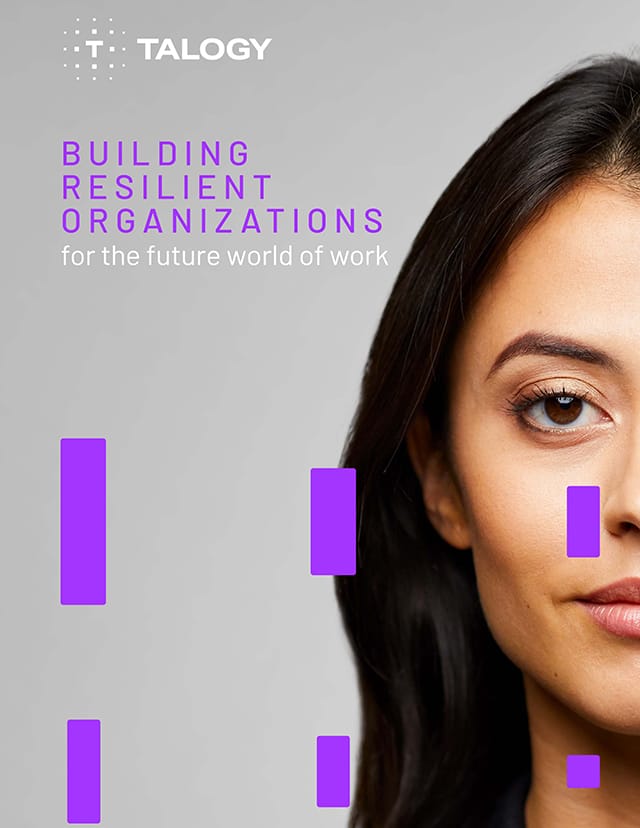Written by Dr. Jo Maddocks, Chief Psychologist
Previously published by PSI Talent Management or Cubiks, prior to becoming Talogy.
The global pandemic may be abating in many countries, but the after-effects are likely to be with us for some time to come. For over a year, the threat of Covid-19 and its restrictions have become a pervasive and perpetual stressor in many people’s lives. We have become accustomed to enduring the challenges this presents, but the prolonged nature of such adversity may take its toll – not least on those in the helping professions such as caregivers, medical staff, and teachers. A recent survey by the British Medical Association (BMA) says that 32% of doctors (double that of 12 months ago) are considering early retirement due to exhaustion.
What is burnout?
The World Health Organization (WHO) recognizes burnout as a syndrome brought about by chronic workplace stress. In my previous resilience blog, I described the cumulative “drip-drip” impact of stress, and how less prominent but more permanent stressors can be far more debilitating over time. Stress directly affects our performance. A small amount of stress can make us more alert and productive, but our bodies do not cope well with repeated spikes in adrenaline. Very soon it will cause us to feel emotionally and physically exhausted and impair our cognitive performance. As shown in the diagram below, it can take several hours to clean out the stress hormones from our body. If we experience regular small stressors during the day over several weeks or months, it is unlikely we will recover sufficiently and may be perpetually under-performing.

Understanding our emotional reactions to stress
Stress is experienced in the body as emotion, so paying attention to our emotions is one of the most effective ways of managing stress and preventing exhaustion and burnout. In the previous blogs in this series, I described four stages of resilience (Survive, Adapt, Recover, and Thrive) using the PSI Thrive cycle. Each of these stages is typically accompanied by emotions as shown in the emotions wheel below.

Emotions may be split into two basic dimensions: the intensity of our emotions (high or low) and the valence of our emotions (positive or negative). These produce four emotional zones (Stress, Burnout, Renew, and Energize) which correspond with the four stages of resilience (Survive, Adapt, Recover, and Thrive). As with the Thrive cycle of resilience, our emotions will often progress in a cyclical direction. For example, under adversity we may experience intense negative emotions (Stress) where we feel overwhelmed and anxious. Prolonged stress will cause us to feel tired and possibly unwell (Burnout). The way out of this destructive pattern is to practice calmness and relaxation (Renew), which helps us re-engage (Energize).
Considering the following questions:
- How much time do you spend in each of the four emotional zones?
- How do you perform in each zone?
- What gets you into the Stress zone?
- What could you do to spend more time in Renew?
Practical steps to take today
There are several things we can do to avoid falling into Burnout.
- Use the emotions wheel to monitor your feelings: Being aware of the variation in our emotions can help us to manage them more effectively. It may be that at certain times of day you feel more energized and other times of day you are feeling tired. Plan your workload and breaks to suit your emotional patterns.
- Spend time in Renew every day: Waiting for the weekends or holidays to recover or “switch-off” is insufficient. The more often you can check in with your emotions and spend time in Renew, the more effectively you will perform and cope with daily challenges. It will also help you to engage in recovery sleep, essential for the following days’ activities.
- Learn how to Renew: This may involve small actions such as chatting with a friend, exercising, or resting. Learning to Renew is also a skill we can develop using techniques like breathing exercises, practicing mindfulness, and positive thinking.
- See Renew time as productive time: People often consider “time-off” as being unproductive and wasteful, which in itself may create feelings of stress and guilt. However, neuroscience tells us that time in Renew helps quiet the “noise” in our brain. This helps us to hear the quieter intuitive signals that give us insight, help us resolve problems, and improve creativity.
- Get the right balance between Energize and Renew: Different personality types may prefer to spend more time in each of these zones. An introvert may prefer being in Renew and could find too much time in Energize as stressful. An extrovert may have the opposite preference and find that more time in Energize helps reduce feelings of stress.
- Notice early signs of stress: An unfortunate side effect of stress is we become less aware of our feelings. The reason we move into Burnout is because we haven’t noticed and addressed feelings of stress sooner. To counter this, start by recognizing feelings of stress early and identify what triggers these feelings. For example, it may be certain people or situations – in which case, find people or situations that boost more positive feelings.
- Reduce time in the Stress zone: Stress is not all bad. In fact, time in the Stress zone can be very productive in small doses such as responding to urgent demands. The key is to know how to get yourself back into Energize or Renew. For example, taking a break, asking others for help, and being realistic about what is achievable.
- Recognize that all feelings are useful: Negative feelings may feel unpleasant, but they are also helpful and essential. Think of all feelings as your friend; they are messages from our body telling us vital information to direct our attention. Just like when the workforce gives feedback to the managers in an organization, it may be difficult to hear. But the cost of not listening to employees would be catastrophic in the long run, just as it would be to ignore feelings from our body. The key is learning to notice our feelings and what they are telling us. For example, in Burnout the body is telling us that we need to rest, slow down, and let go.
You can’t pour from an empty cup
The main takeaway is to acknowledge your emotions, recognize what zone they fall into, and take steps to properly manage the associated stress. Burnout is a real, palpable effect of overworking yourself, and you have to put your emotional wellbeing first if you want to sustain your productivity for years to come.


